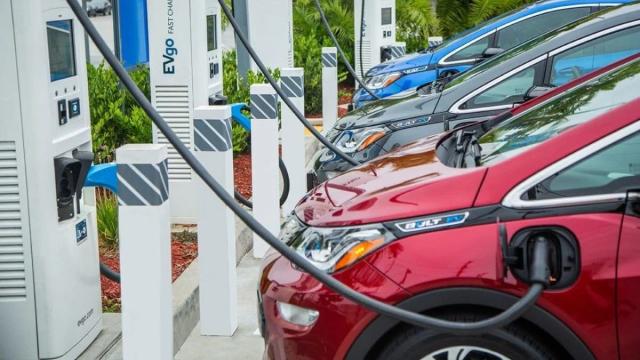In the wake of the United Kingdom Prime Minister opening discussions on potentially delaying the country’s ban on the sale of new gas and diesel cars, we thought it might be a good idea to look at how well some countries are prepared for their own self-imposed bans. How many countries are actually on track to meet their zero emissions mandates, and what are they doing—or not doing—to keep things on track. We’ll also take a look at some states here in the U.S.
Thirty countries have signed the Glasgow Declaration, which stipulates all new vehicle sales must be zero emissions by 2040. Twenty-one other countries have created their own plans to ban new ICE vehicle sales earlier than a 2040 deadline. Further, there are dozens of major cities, states, and municipalities that have drafted their own bans. Perhaps most notoriously, California has said it will ban all ICE vehicle sales by 2035, despite no federal country-wide proposal even having been considered. Connecticut, Maryland, Massachusetts, New Jersey, New York, Oregon, Rhode Island, and Washington have also signed on to follow California’s strict emissions plan.
Notably absent from any wide and sweeping zero-emission vehicle sales pledges are the United States, Japan, Russia, and France.
If you’ve been paying attention for the last few years, it won’t come as a surprise that Norway is far and away the global leader in electric vehicle adoption. The country’s imposed an ambitious ICE vehicle sales ban by 2025. In 2022 Norway saw new car sales reach 80 per cent electric, giving them just two years to solve that final 20 per cent. There are still some minor issues, like the availability of charging for apartments and city dwellers, and peak demand charger capacity. Considering how much the country has done to get to this point, I don’t see reaching 100 per cent being much of an issue.
While Norway has the highest percentage of EV adoption, China has seen the largest quantity of EVs sold, and it’s a growing number every year. More electric cars were sold in China last year than every other country in the world combined. 22 per cent of new vehicles sold in China across 2022, totalling 4.4 million sales (an additional 1.27 million plug-in hybrids were sold that year). Sales are expected to clear 7 million in 2023. China has managed to make this happen because of the low cost of EVs made in the country, the most comprehensive state-supported charging infrastructure, consumer subsidies, tax incentives, manufacturer subsidies, penalties for buying a gas car, and penalties for producing gas cars. China is expected to exceed 90 per cent of electric car sales by 2030, well on track for a full ICE ban in place for 2035.
India is an example of a country that is lagging behind much of the rest of its global power contemporaries, despite having signed the Glasgow Declaration. As much as 70 per cent of India’s car consumers have indicated they’re willing to consider an electric car, but the country simply isn’t ready. Infrastructure is certainly behind the 8 ball, and even the availability of EVs is lacking in the country. New electric vehicles have started to trickle in which are aimed specifically at the Indian market, and cost parity between ICE and EV has been achieved. Projections indicate India will hit 10-15 per cent market penetration by 2030. Can it get from 10 per cent to 100 per cent in just ten years? The country is ambitious about cleaning up its air quality, and EVs would go a long way toward making that happen.
In 2020 California rolled out a plan for mandating zero-emissions vehicle sales. Under the plan, confusingly, plug-in hybrids are considered zero-emissions vehicles, and the state doesn’t differentiate between battery electric vehicles, PHEVs, and hydrogen fuel cell sales. With that in mind, California has said it’s seen a quarter of all new cars sold be ZEVs, some 126,000 cars in Q2 of 2023. That’s up from about 7 per cent when the plan was announced three years ago. The plan requires 35 per cent of new cars, SUVs, and small trucks be ZEV by 2026, increasing to 68 per cent in 2030, and 100 per cent in 2035. With this trajectory and continued growth, California might be able to meet this mandate by 2035, but only if it heavily invests in charging infrastructure and shoring up its electric grid.
EV sales may be booming for California, but the rest of the U.S. is well shy of that number. As mentioned above, eight additional states signed on to California’s ZEV plan. In Q2 of 2023, just 370,409 EVs were sold nationwide, meaning just California accounts for a third of American electric/electrified sales. Interestingly, most EVs not sold in California head to Florida or Texas, neither of which supported the California ZEV mandate. Connecticut, for example, has introduced cash rebates for EVs priced up to $US50,000, and saw EV sales bloom 42 per cent year over year.
Is the world ready for an all-electric future? It’s certainly going to take a lot of work to get there, and some countries are more ready than others. Right now it takes a large government-driven incentive program, as well as buy-in from the public. We just haven’t seen that in the U.S. and likely won’t for a long time. Likewise the U.K. seems too polarized for an EV mandate to take root. If the technology keeps progressing, though, maybe consumers will begin demanding them without help from their individual governments.
Image: Chevrolet
Want more Aussie car news? Here’s every EV we’ve reviewed in the last two years, all the EVs we can expect down under soon, and our guide to finding EV chargers across the country. Check out our dedicated Cars tab for more.
